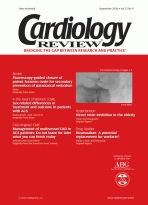Continuing Medical Education Exam
Target: Stroke & Arrhythmias
“Sex differences in ischemic stroke among patients with atrial fibrillation”
Learning objectives
Describe stroke and hemorrhage rates in a cohort of men and women with nonvalvular atrial fibrillation, the impact of warfarin therapy on this group, and the implications for patient risk assessment.
1. A total of 5795 women and 7764 men were included in the Anticoagulation Risk Factors in Atrial Fibrillation (ATRIA) study. The women in the study were older than the men and were more likely to have a history of __________ or ___________.
a diabetes; dyslipidemia
b obesity; coronary artery disease
c hypertension; stroke
d renal impairment; congestive heart failure
2. After adjusting for risk factors for stroke, warfarin therapy correlated with a ____ reduction in the rate of thromboembolism for women and _____ reduction in men.
a 20%; 10%
b 30%; 20%
c 50%; 30%
d 60%; 40%
3. The ATRIA study showed that women with atrial fibrillation have a _____ higher rate of stroke than men.
a 50%
b 60%
c 75%
d 80%
4. According to the study investigators, increased stroke risk in female subjects may be related to ___________.
a higher rates of obesity in women
b greater incidence of migraine headaches
c high levels of prothrombotic factors
d elevated triglycerides
5. Throughout the 15,494 person-years during which the subjects were not taking warfarin, 394 thromboembolic events occurred, of which _____ were ischemic stroke.
a 79.0%
b 83.9%
c 89.7%
d 93.7%
Target: Heart Failure
“Outcomes in women versus men with heart failure and preserved ejection fraction”
Learning objectives
Examine sex-related differences in clinical presentation, morbidity, and mortality in a clinical trial cohort of patients with heart failure with preserved ejection fraction.
1. Of those enrolled in the Digitalis Investigation Group (DIG) study, women subjects with heart failure and preserved ejection fraction (HF-PEF) less often had _________ compared with men.
a a history of hypertension
b a prior myocardial infarction
c renal impairment
d pre-existing type 2 diabetes
2. The observed sex differences in clinical presentation of HF-PEF may be the result of several biologic factors. Women have been reported to have a distinct ______ cardiomyopathy with increased wall thickness and left ventricular mass.
a diabetic
b hypertropic
c congestive
d restrictive
3. More women in the DIG study were taking _________ at baseline than men.
a ACE inhibitors
b nitrates
c vasodilators
d diuretics
4. Hypertension was shown to be the chief cause of HF-PEF in less than a third of the women in the study cohort. However, ______ was noted as the primary cause of heart failure in half of the women in the study.
a dysrhythmia b dilated cardiomyopathy
c ischemia
d valvular disease
5. The 70-year-old woman in the case study presented to the ER with acute decompensation of HF-PEF. Non-adherence to antihypertensive medications and a large salt load likely precipitated the acute decompensation in this patient. Treatment recommendations for such a patient include aggressive blood pressure control with consideration of all but which of the following?
a ACE inhibitors or angiotensin II receptor blockers
b calcium channel blockers
c diuretics
d beta blockers
